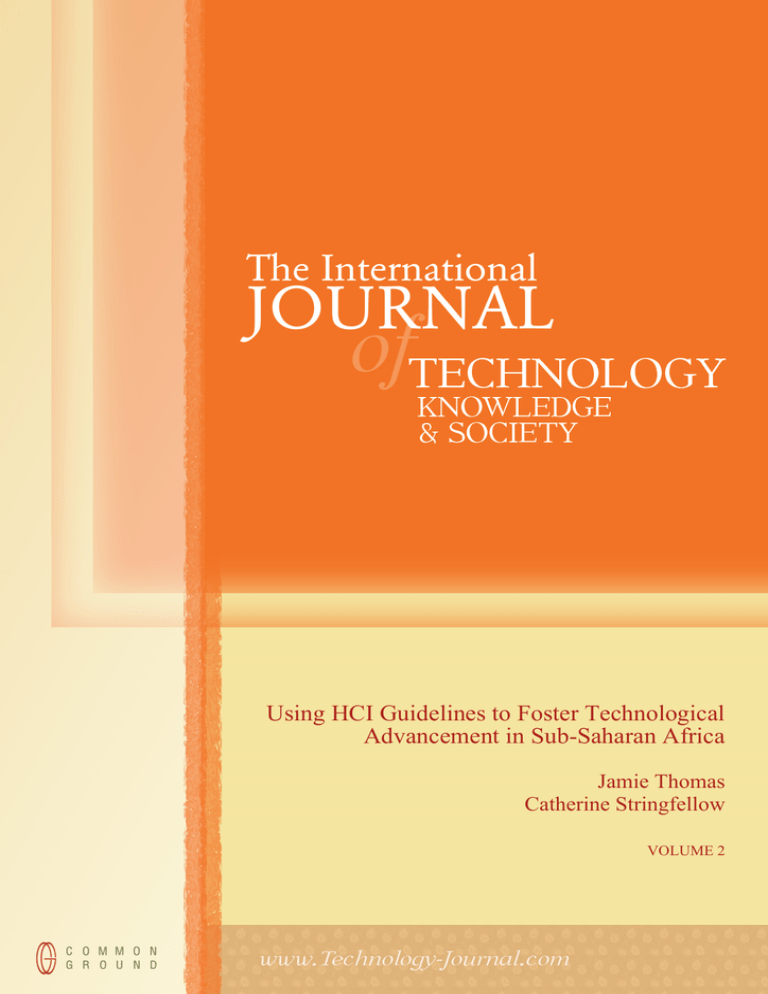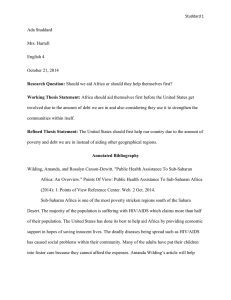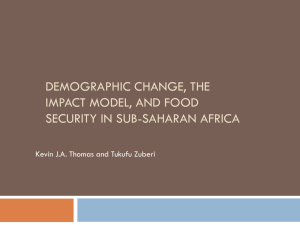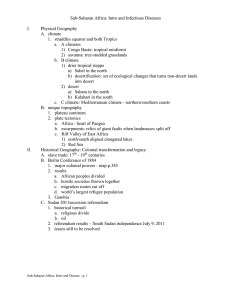
Using HCI Guidelines to Foster Technological
Advancement in Sub-Saharan Africa
Jamie Thomas
Catherine Stringfellow
VOLUME 2
!"#$ %& '! (
)
&* %+!
)
* ,) -../) 0 !
+ %&
%*&'!
)
'+#
((
& % ,1%+!
)
* )" (
2 -../3 )
* ' &4
'% &3*4
2 -../3* ! ) ' , ,) &)
'!(' &4 ((
% &*'& &*
*)
+! 5 &
((
& % ,1%+!
)
* )"1 # ,
&% ,
' %&' # 5 )') * 6% ') * ,)
'"&'(* '+!*' ,(' *
!
!&)
" *&* &7 , '& 5& ( 5')
&%* 5 &
%& * * 5*%,# &* '& &)))*( &&7) '* &() ,% , &
#&)
"
3 %*&'!)
'4
'& 5 )
* &8('#+ & & ,% , ) % &)
&()
**) 5& (
%+!
)
* & & &()**) *' ,
&)6%)
&)* !'*
' 9 "$*% &: (( "& % , %+!
)* )" (;
<=>-$>//?
1%+!)
* &)
!"#$ %& '! (
@%& '! %!! ' &**%+() ,5 & %+!
)') '& &5& ,+# ** )
'
& ** *
# * )
((
((
& % ,0 '&8% ' "%'" %*)"
& % , 5 '& (
,) &* & %" '
&' &(%!) '
)
*' &&5& ,
#( %*&5&
!# * )"*#* (
Using HCI Guidelines to Foster Technological Advancement in
Sub-Saharan Africa
Jamie Thomas, Midwestern State University, United States of America
Catherine Stringfellow, Midwestern State University, United States of America
Abstract: In an area that is more commonly known for its political instability, economic stagnancy, and social injustices,
technology is trying to get its legs amid the constantly shifting sands. Many of those who have not benefited from the technological advancements are the people living in the area of sub-Saharan Africa (excluding the region of Southern Africa).
There are countless obstacles in the way of establishing an information society including: social misgivings, adverse physical conditions, and lack of a sufficient information infrastructure. The technology that is used in the western world and
even the Asian areas are poorly suited for the climate of sub-Saharan Africa and modifications to the technology will be
expensive and most likely ineffective. Principles from the field of human computer interaction (HCI) can play a key role by
aiding in the development of heuristics and guidelines to be used in designing computer systems to help foster acceptance
of the technology. Due to the unique circumstances in this region, traditional methodologies require refinement and new
approaches to design are needed to ensure the success of a new technology. It is the intent of this paper to review existing
HCI heuristics and guidelines and suggest modifications to make the existing heuristics and guidelines compatible with the
needs of the average user in sub-Saharan Africa. In addition to reviewing existing HCI heuristics and guidelines, new
heuristics and guidelines will be proposed to embody the culture and people of the region.
Keywords: Human Computer Interaction, Technology in Developing Countries
Introduction
VER THE PAST 50 years information
technology has invaded every crevice of an
individual’s life so much that it is hard to
believe there are still those that have experienced only small amounts, if any, of technologies’
influences. In more recent years, the development
of technology has been so rapid that it is difficult to
bring the underdeveloped areas of the world up to
speed. The lack of development in information
technology (IT) in these areas may serve to further
distinguish the “developing” countries from the
“developed” countries, further defining the digital
divide on a global scale [3]. Despite Africa being the
second largest continent, it is the least computerized;
even Antarctica has a higher per capita use of IT than
Africa [11]. Many of those who have not benefited
from the technological advancements are the people
living in the area of sub-Saharan Africa. (This paper
refers to East Africa, West Africa, and Central
Africa, excluding Southern Africa from the subSaharan region). In an area that is more commonly
known for its political instability, economic stagnancy, and social injustices, technology is trying to
get its legs amid the constantly shifting sands.
Due to the unique circumstances in sub-Saharan
Africa, traditional design methodologies require refinement and new approaches are needed to ensure
the success of a new technology. Employing
O
guidelines from human computer interaction (HCI)
can play a key role in developing systems that can
foster acceptance of the technology. These guidelines
must be incorporated into the design process to be
acceptable to the people of the region. This paper
reviews existing HCI guidelines and suggests modifications to make them compatible with the needs of
the average user in sub-Saharan Africa. In addition,
new guidelines will be proposed to embody the culture and people of the region.
Section 2 discusses the obstacles that prevent the
creation of an information society in sub-Saharan
Africa. Section 3 analyzes Hofstede’s dimensions
used to describe a culture [6]. In section 4, the impacts of the various cultural dimensions are combined
with HCI concepts to create new and modified
guidelines for the specific region of sub-Saharan
Africa. Section 5 presents concluding comments as
well as suggests future research.
Background
There are numerous social and environmental
obstacles in the way of establishing an information
society in sub-Saharan Africa. There are many who
oppose the development of technology in the region
for a multitude of reasons, some stemming from the
turbulent history of the area and others who cannot
fathom the uses of technology. The diversity of the
area also creates unique circumstances which affect
INTERNATIONAL JOURNAL OF TECHNOLOGY, KNOWLEDGE AND SOCIETY,
VOLUME 2, 2006
http://www.Technology-Journal.com, ISSN 1832-3669
© Common Ground, Jamie Thomas, Catherine Stringfellow, All Rights Reserved, Permissions: cg-support@commongroundpublishing.com
INTERNATIONAL JOURNAL OF TECHNOLOGY, KNOWLEDGE AND SOCIETY, VOLUME 2
the development of successful applications. Environmental conditions add yet another hindrance to the
development of technology.
Social Obstacles
The most pressing deterrent of technology seems to
be the lack of public sentiment to encourage government support or outside investors to lay the foundation needed to bring the region into the age of technology. Governments that do encourage an information technology (IT) policy have often had negative
results, such as valuable funding being spent on unused equipment or increasing the dependency on
foreign personnel for the know-how, which creates
resentment among the local communities [11]. Many
of the national governments in the region are newly
formed and still trying to establish structure within
themselves, so long term incentives, such as IT development, are not a top priority. The masses are
more concerned with meeting everyday needs like
food, clothing, and medical care. Until individuals
can feel the benefits that technology can bring to
their everyday life, it is unlikely that they will support its development over other issues such as education and agricultural development [10].
Many of the IT projects undertaken in this region
fail for numerous reasons, such as poor management
and high IT personnel turnover [9], so investors are
hesitant to undertake expensive endeavors. Investors
may also be concerned with the local hiring process
where positions, such as a project manager, are filled
not based on experience or ability, but based on who
knows who. Without a change in public sentiment
towards technology and without the government
making IT a priority, there is little chance investors
will bring a real long term commitment, as well as
the capitol and supplies needed, to make IT a reality
for this area [9, 10, 15].
There are other social issues that complicate the
development of IT further. Numerous native groups
are concerned with technology changing the rich
culture of the area, a culture that has been oppressed
and down trodden by colonization and has been
steadfastly held to by locals [9, 10]. Computers are
seen as a threat to the system of social and cultural
behaviors such as the concepts of authority and (lack
of) timeliness [10]. Technology is seen as “foreign”
and thereby brings negative associations and hinders
the ability to convey the advantages of technology.
In addition, a multitude of languages exist across
the region, some with unique characters and varying
grammatical rules that complicate the development
of computational aids for morphological analysis.
Morphological analysis serves as an enabling technology on which the development of tools and applications, such as an electronic dictionary and text to
speech systems, can be built [12]. Further complicat-
ing language barrier issues are that some of the native
languages do not have any written form at all. In order for technology to be truly inclusive and avoid
marginalization, all of the language barriers must be
addressed.
There is generally a low level of education available to the masses and almost no IT education. Very
few countries in the region have any training programs for IT and even less have universities with a
computer science department. The education that is
afforded is outdated, overpriced and limited in scope
[15]. The course materials are designed outside of
sub-Saharan Africa and are not adapted to the region’s issues and therefore have little relevance or
application to the conditions that exist in the area
[10]. Some computer science departments have only
a few outdated computers for professors and students
to share and no internet access.
A far reaching problem is the cost of the technology [7]. For those that have access to the internet,
it can cost up to $70 dollars for dialup connection
for 20 hours of service a month [7]. Internet cafes
have become popular in urban areas where access to
the internet is cheaper, but even these are costly to
the average user, who often lives on only a few dollars a day [15]. Cell phones have begun to make an
impact in this area [2], but have limited capabilities
and since most cell phones applications are small
and menu based, there is little transfer of knowledge
from cell phone applications to applications developed for more complicated systems. Much of the
software used is developed outside of the area; it is
expensive; and requires hardware that is equally as
expensive to function properly. In the sub-Saharan
area, most can only afford outdated technology [15].
There is little infrastructure throughout the area
and most of that is composed of old, outdated technology that has fallen into disrepair, because there
are few IT professionals with the ability to maintain
it. Many of the computer systems and IT professionals in sub-Saharan Africa were brought into the area
by foreign forces, such as the World Bank and the
United Nations, while the countries were still heavily
colonized [10]. The technology introduced to the
area was developed in other areas of the world and
when a country returned to sovereign status much
of the technological experience left [10].
Environmental Obstacles
Environmental conditions also present obstacles to
IT development. There is often a lack of consistent
electricity even in urban areas. Many businesses rely
on generators to produce power when electricity is
not available. The more rural areas do not have
electricity at all [15]. Yet another issue is the sand
JAMIE THOMAS, CATHERINE STRINGFELLOW
that is a constant and unavoidable havoc on the
electrical components of the technology [15].
Despite all of the obstacles, technology is still
slowly trying to establish itself in the area. There are
those individuals that are trying to support and nurture its development. In 2003, the United Nations
World Summit on the Information Society declared
that applications should be “accessible to all, affordable, adapted to local needs in languages and culture,
and [to] support sustainable development [13].” For
sub-Saharan Africa to grow and prosper in the twenty
first century, technology must succeed by designing
applications that embody the spirit of the people and
respect the culture of the area.
The Role of Human Computer Interaction
There are a number of ways that HCI guidelines used
in developing computer systems can contribute substantially to the successful compatibility and acceptance of the technology produced for sub-Saharan
Africa. Considering the cultures of the region in the
development of technologies increases the likelihood
of success [3]. Technology that is used in the western
world, and even the Asian areas, will be poorly suited
for the culture of sub-Saharan Africa and modification after development will be expensive and most
likely ineffective. The only way to ensure the future
growth of technologies is to take the time and get it
right. The area of sub-Saharan Africa must come
online with technology in order for its economy to
be able to benefit from a global marketplace.
Defining the Average User
Understanding the average user in sub-Saharan
Africa is a key part in defining guidelines for the
development of technology. The average user needs
to be defined in a broad sense to encompass this immense and diverse area. Hofstede’s five dimensions
of culture (power distance, individualism versus
collectivism, masculinity versus femininity, uncertainty avoidance, and long versus short term thinking) are often used in HCI to help define an average
user [6].
Power distance refers to how much inequality in
power is expected and accepted. Most of sub-Saharan
Africa is considered to have a relatively high power
distance index. This translates into a very hierarchical
view of authority, where superiors are often paid
significantly more and instructions are strictly adhered to without questioning [6].
The cultural dimension of individualism versus
collectivism looks at how much emphasis is put on
self versus the community. The people in the area
of sub-Saharan Africa are much more inclined to a
collective way of thinking. Government enforces
policies that favor the group over the individual and
invasion into a person’s private life is tolerated.
Other governmental policies may include controlling
the economy and the press. The family values harmony over all else; silence is better than speech [6].
The dimension of masculinity versus femininity
is concerned with differences in gender roles. The
area of sub-Saharan Africa is neither a highly masculine nor a highly feminine culture. There is some
blurring of roles of men and women, as well as a
lack of strong definitions of a ‘man’s job’ versus a
‘woman’s job’ [6].
Some cultures have an inability to cope with the
unknown and this causes anxiety and uncertainty.
The uncertainty avoidance dimension concerns the
level to which a culture as a whole deals with the
unknown. How a society deals with uncertainty can
influence values regarding everything from formality
of religious requirements to tolerance for obscurity.
Sub-Saharan Africa lands in the middle of the uncertainty scale, so there is some ability to cope with the
unknown, but there is a preference to be more definite than not [6].
The last dimension concerns long versus short
term thinking. Unfortunately there is not a lot of information referring to sub-Saharan Africa in Hofstede’s study regarding this dimension, however, it
would seem that the sub-Saharan area is more inclined to short term thinking and part of that can be
attributed to the instability of the area, not being able
to make plans for the long term due to rapid changes
in political and economic conditions.
Hofstede’s approach is flawed [8], for example it
presumes there is one dominating culture for a
country, when in fact there may be several unique
cultures within a country’s border. Despite this,
Hofstede’s research still provides insight into defining a culture’s pattern of thinking and feeling that
can affect how a culture chooses values, symbols
and rituals. His research was conducted 20 years ago,
however, cultural behaviors are instilled into the
culture over hundreds or even thousands of years
and will not change dramatically in a short period of
time.
Impact of Cultural Dimension on Hci
Knowledge of cultural dimensions should be considered in designing computer interfaces and can
affect user interface development (UID) in several
ways. In regards to the power distance dimension,
since the mental models of hierarchies are perceived
as taller and more rigid, there should be a strong
emphasis on expertise, authority, and certifications
to prove worthiness and validity of information [6].
Security is highly important and the user would expect restrictions and barriers to information. For example, access to information in a system should be
INTERNATIONAL JOURNAL OF TECHNOLOGY, KNOWLEDGE AND SOCIETY, VOLUME 2
arranged according to a user’s position and the “need
to know,” rather than an open system where anyone
can access all parts of the application.
The influence of a collective way of thinking on
UID is profound. Since an individual’s motivation
is based on downplaying personal successes in order
to elevate the group, individuals may be less likely
to relay personal information to avoid distinguishing
themselves from the group. Communication is often
subdued and uncontroversial. Rewards are for the
furtherance of social and political policies. There is
an emphasis on tradition and history; elders being
wiser and more experienced. This emphasis on tradition and history makes change slow and at times
change is strongly resisted [6].
The remaining dimensions, masculinity vs. femininity, uncertainty avoidance, and short term thinking
also affect HCI in different ways. The design of
systems should be designed to generate attention by
using visual aesthetics and appealing to unifying
values rather than a masculine society [6]. High uncertainty avoidance can be designed for in HCI by
using a simple, limited arrangement of options and
redundancy of cues, while a system to suit low uncertainty avoidance should encourage exploration
through an abundance of options [6]. Since the area
of sub-Saharan Africa fits in the middle of the two
extremes, systems need to balance these options. The
last dimension, in which sub-Saharan Africans are
more inclined to short term thinking, suggests using
a clean, functional design that clearly defines and
helps the user achieve their goal quickly. A lot of
patience should not be required to navigate the system or achieve goals [6].
Tables 1 and 2 describe the dimensions, associated
issues and HCI guidelines that would be useful to
develop computer systems to conform to the cultural
nuances and issues specific to the sub-Saharan region. Table 1 focuses on guidelines associated with
Hofstede’s dimensions. Table 2 focuses on three new
dimensions and guidelines for them, which provide
a more in-depth understanding of the region. These
guidelines are described in more detail in the next
two sections.
Guidelines for Existing Cultural
Dimensions
The uncertainty avoidance in the sub-Saharan region
will make new users more likely to be apprehensive
and less confident than experienced users. Systems
need to be designed to create a feeling of comfort
and security. One HCI guideline states that applications should offer error prevention and simple error
handling [4]. In western and Asian cultures the error
handling capacity of technology can be glossed over
with minimal commitment; as long as the system
does not crash and the data can be restored, most
users will be content. However, in sub-Saharan
Africa there will need to be a huge commitment to
ensuring that the user can avoid errors and recover
when necessary. Applications should allow easy reversal of actions [4] for small errors. In addition, a
user should be informed of severe consequences of
their actions, for example, a user should be made
aware that they must save before closing the application.
Most sub-Saharan users will be first time users
with no previous knowledge base on which to build.
There is little to no internet connectivity in the area,
so online help and fixes are not a viable option. There
is limited experience with technology, so there is no
user network for which users can probe for answers
[7, 15]. An additional requirement may be to create
systems that have the answer within themselves and
the ability to relay the information to users in a
simplistic step-by-step format. Without a comprehensive tool to assist users in using the system, it
will most likely not be used.
Another useful existing HCI guideline states to
make components, such as user options, tasks and
selections, visible and obvious to the user [4]. The
most common (which does not imply widespread)
use of the computer terminal by the urban subSaharan user is at a internet cyber café. This provides
some knowledge base; however, since the user of
the computer terminal is charged by the hour, it
would be too expensive for the average person to
spend a substantial time browsing the internet and
hence only
JAMIE THOMAS, CATHERINE STRINGFELLOW
Table 1: Dimensions, Issues and Guidelines
Dimensions
Associated
Issues
Uncertainty Avoid- First Time Users/
ance [6]
Novices
Existing Guidelines Modification
1. Offer error prevention and simple error
handling [4].
2. Make components
visible and obvious
[4].
3. Permit easy reversal of actions [4].
New Guideline
1. Emphasize error 1. Applications should
avoidance.
assist user in error recov2. Components and ery.
applications named to
convey purpose.
3. Ensure users know
consequences of actions.
Short-Term Think- 1. Recent conflicts 1. Simplify the struc- 1. Goals achieved
1. Allow various color
ing [6]
ture of tasks [4].
quickly with minimal palettes and images to
steps.
aid memory.
High Power Distance [6]
1. Political Instability
2. Differences in
status of people
1. Store sensitive data in
neutral and secure locations.
2. Use passwords and
security features to create separation.
Collectivism [6]
1. Group success
more valued than
individuals.
1. Create separations
that are based on group’s
status not an individual.
Masculinity vs.
Femininity [6]
1. Blurred gender
roles
1. Incorporate unifying
values; avoid gender
distinctions.
a limited amount of experience can be assumed for
even these users [7, 15]. Designing for a group that
consists predominately of new users makes it imper-
ative that what they can accomplish with the software
be evident to the user immediately. Even the name
of
Table 2: New Dimensions, Issues and Guidelines
New Dimensions
Associated Issues
Existing
Guidelines
Modification
New Guideline
Diversity
1. Different languages.
2. Pre-conceived notions (non-local designers)
1. Design for
2. Use defamiliarizacultural diversity tion rely less on afford[4].
ances[1].
2. Use affordances [4].
Education Level
High Illiteracy Rate 1. Offer informative feedback
[4].
1. Applications
should “speak” to
users to convey options and errors.
Environmental Conditions
Inconsistent Power
Source
1. Auto-save data frequently to non-volatile state.
2. Use innovative
power sources like
wind up cranks.
1. Create adaptive applications to handle
written and oral communication in multiple languages.
2. Use locally understood and accepted
terms and images.
INTERNATIONAL JOURNAL OF TECHNOLOGY, KNOWLEDGE AND SOCIETY, VOLUME 2
the application and its components should reflect its
purpose, until there is a knowledge base to build on
for future technologies. Components should be
named appropriately and provide some insight, for
example with tool tips, for the users. There is no
transfer of knowledge for the first time user, so affordances that many designers rely on are potential
pitfalls. For example, new users may not be familiar
with concepts such as using an underlined word as
a hyperlink, instead they may perceive an underlined
word as being emphasized [14].
The sub-Saharan’s turbulent past and rapidly
changing political conditions may contribute to short
term thinking of many in the area. Regions in this
area have been in conflict with each other in the recent past, so designers will have to take additional
precautions not to offend factions by using terms or
pictures that may be associated with the opposing
group. Since many tribes use colors as an identifying
mark, color schemes for an application should be
customizable. Another HCI guideline states “simplify
the structure of tasks [4].” This is a good foundation;
however, designers may also aspire to create applications that allow the user to complete their goal with
a minimal number of sub-tasks.
The high power distance in Sub-Saharan Africa
contributes to a society clearly divided by layers of
authority. Superiors are expected and allowed to
reign absolutely, with little opposition from subordinates. However, given the “newness” of many of the
governments in the region it is necessary to make
sure sensitive data is stored in neutral and safe locations. If a political uprising takes place, it will be
important that data can be maintained uncorrupted
for future reference. Despite the possibilities of upheaval, designers should create applications that are
respectful of the status of individuals and the division
of power in the area. Applications should use passwords and other security features to create a separation of data and functionality.
The collectivist thought of the people of the area
may help to define that separation. People work together for the good of the group and individual success is not important. Separation in applications may
fall into authentication levels relative to their importance in society and should be readily discernible
from one level of superiority to another. In addition,
separation should not be based on gender, since the
culture is not strongly masculine or feminine. The
design should use unifying values to focus on the
application’s task.
Newly Proposed Cultural Guidelines
Diversity is an important aspect of any society today
and should not be overlooked. Hofstede’s research
did not address this dimension: he presumed a single
dominate “personality” for a region. HCI guidelines
advise designing for diversity and in the case of subSaharan Africa following that advice makes for a
substantial undertaking on the part of the designers.
Many African nations have a multitude of national
languages, some with European influence and others
that are completely native to the area. There are
several forms of character sets that are associated
with the multiple languages. Some of the languages
have no written form, which complicates the issue
further [12]. Computer systems and applications will
need to deal with multiple languages.
Another aspect of culture concerns informality
and timeliness; many sub-Saharan cultures do not
respond well to tightly structured settings [10].
“People from diverse cultures may have diverse ways
of communicating relating to the underlying concepts
in their culture, [while] an electronic tool often determines structures of communication, i.e. social
protocols, communication procedures, turn-taking,
interrupting, power distance [16].” Flexibility will
need to be integrated into software, which is not necessary for software developed for other areas of the
world. The navigation design dictates there should
be multiple ways to achieve the same result. Software
applications can incorporate some of concepts of
web design, such as offering a navigation bar on the
side or top that allows the user to skip around the
application with minimal steps. Using similar principles from web based interaction will build on the
limited knowledge base that does exist and create a
base for new users who will eventually use the World
Wide Web (WWW).
Diversity is also a concern where the culture of
the developers and users are different. Any affordances of western and European cultures should be
strongly evaluated prior to use as there may still exist
certain groups with strong resentment of the colonizing nation. Icons and images should reflect as much
of the sub-Saharan culture as possible. The trashcan
or mailbox icons may need to be modified, while a
concept like recycling may need translation to a term
more widely understood. Many western and
European cultures perceive Africans in a way that is
demeaning and contrary to reality. Any preconceived
notions that Africans are uncivilized or primitive
cannot be any way manifested in the systems designed for the region. An alternate approach to using
affordances may be to use “defamiliarization [1]”.
Defamiliarization is a literary technique used to make
something look new by approaching it from a different perspective, thus causing critical reflection and
creating new possibilities in design [1]. If asked to
describe a computer application to a citizen of
Jupiter, the describer would be forced to pay very
close attention to details, the nature of how and why
something works and eliminate affordances. This
JAMIE THOMAS, CATHERINE STRINGFELLOW
approach could be equally useful for applications
developed by designers for cultures with which the
designer may not be sufficiently familiar.
The high rate of illiteracy is also a formidable
barrier for developers. Education level is not considered in Hofstede’s research, but is an essential
dimension when addressing cultural issues in application development. Many applications that will be
for public use, for example in bus stations or stores,
may need to provide verbal instructions and feedback
to the user in several commonly used languages. HCI
techniques that have been devised for the visually
impaired may be useful in this situation. A “talking
tool tip” that reads a selection from the menu as the
mouse touches it will guide the user and also “teach”
the user to become familiar with the words on the
screen. Error messages and help screens will also
need to be audible.
Guidelines for Environmental Conditions
The lack of consistent electricity will require some
modifications to applications. For any user, the loss
of substantial work due to an unexpected power loss
is frustrating and costly, but in the sub-Saharan region power loss should be treated as an expected
occurrence by application designers. Applications
should frequently auto-save information in a nonvolatile state without interrupting the user. Performance should be a secondary consideration to ensuring
data recovery in the event of power failure. For those
regions where power supply is more consistent, applications should allow the user to disable this feature, but adequate warning should be given for new
users with no understanding of the consequences.
Developers should work towards innovative power
sources, such as wind up cranks [5] and increasing
the lifespan of batteries, to ensure that once a user
has invested the money the computer can be used
even in the most rural areas.
Conclusion
There are still many unanswered questions that future
research may address concerning technology and its
integration into the sub-Saharan region. First, more
research may be conducted to further expand and
increase the accuracy of the cultural dimensions
defined by Hofstede’s research. Second, usability
analysis and testing of existing and prototype software being developed for the sub-Saharan region in
the region should be performed. Third, empirical
analysis should be conducted to prove the validity
of the modified and proposed guidelines presented
in this paper.
Over the next few years, Sub-Saharan Africa will
experience the same technological explosion that
many around the world have already experienced. It
will be extremely important for the developers of the
technology to be as inclusive and respectful of the
culture as possible. There are numerous barriers,
cultural and environmental, that the field of HCI can
help surmount. Due to the unique circumstances in
sub-Saharan Africa, this paper has proposed modifications to traditional design methodologies and new
design approaches to ensure the success of a new
technology. Guidelines modified and developed for
the area can help ensure that the software developed
is user friendly and inclusive. The extraordinary
culture of the area will inspire creative and innovative uses for technology that can not be foreseen by
the developers, so flexibility will be an essential
element of technology. Amid the shifting sands, the
people of sub-Saharan Africa will find firm ground
with the help of technology on which they can build
a successful and sustainable economy and still retain
its rich and diverse culture.
References
1. Bell, G., Blythe, M., and Sengers, P., Making by Making Strange: Defamiliarization and the Design of Domestic Technologies, ACM Transactions on Computer-Human Interaction, Vol. 12, No. 2, June 2005, pp 149-173.
2. Bulter, R., Cell phones may help “save” Africa, mongabay.com, July 11, 2005.
3. Cogburn, D., HCI in the So-Called Developing World: What’s in it for Everyone, Interactions, Vol. 10, Issue 2, Mar. +
Apr. 2003, 80-87.
4. Dix, A., Finlay, J., Abowd, G., and Beale R., Human-Computer Interaction, 3rd Ed., Pearson Prentice Hall, 2004, 282284.
5. Karaim, R., Innovations 2006: What’s Next, USA Weekend, Dec. 30, 2005 – Jan. 1, 2006.
6. Marcus, Aaron, Global and Intercultural User-Interface Design, The Human Computer Interaction Handbook: Fundamentals, Evolving Technologies and Emerging Applications, Lawrence Erlbaum Associates, Inc., Publishers,
2003, 441-463.
7. Mbarika, V., Jenson, M., and Meso, P., Cyberspace Across Sub-Saharan Africa, Communications of the ACM, Vol. 45,
No.12, Dec. 2002, 17-21.
8. McSweeney, B., Hofstede’s model of national cultural differences and their consequences: A triumph of faith – a failure
of analysis, Human Relations, Vol. 55, no. 1, Jan. 2002, 89-118.
INTERNATIONAL JOURNAL OF TECHNOLOGY, KNOWLEDGE AND SOCIETY, VOLUME 2
9. Mursu, A., Soriyan, H., Olufokunbi, K., and Korpela, M., Information Systems Development in a Developing Country:
Theoretical Analysis of Special Requirements in Nigeria and Africa, Proceedings of the 33 rd Hawaii International Conference on System Sciences, Hawaii, USA, Jan., 2000.
10. Odedra, M., Enforcement of foreign technology on Africa: Its effect on society, culture, and utilization of information
technology, Social Citizenship in the Information Age (C. Beardon and D. Whitehouse, eds.), 1992, 143-154.
11. Odedra, M., Lawrie, M., Bennett, M., and Goodman, S., Sub-Saharan Africa: A Technological Desert, Communications
of the ACM, Vol. 36, No 2, Feb. 1993, 25-29.
12. Pretorius, L., and Bosch, S., Enabling Computer Interaction in the Indigenous Languages of South Africa: The Central
Role of Computational Morphology, Interactions, Vol. 10, Issue 2, Mar. + Apr. 2003, 56-63.
13. Shneiderman, B., and Plaisant, C., Designing the User Interface: Strategies for Effective Human-Computer Interaction,
4th Ed, Addison-Wesley, Boston, Massachusetts, 2005.
14. Walton, M., and Vukoric, V., Cultures, Literacy, and the Web: Dimensions of Information “Scent”, Interactions, Vol.
10, Issue 2, Mar. + Apr. 2003, 64-71.
15. Zachery, P., The African Hacker, IEEE Spectrum Online, 9 Sep. 2005.
16. Zorn, I, Do culture and technology interact? Overcoming technological barriers to intercultural communication in virtual
communities, ACM Special Interest Group Bulletin, Vol. 25, No. 2, Feb. 2005, pp 8-13.
About the Authors
Jamie Thomas
Jamie Thomas obtained her BS in Computer Science from Midwestern State University. She is currently
working on the MS in Computer Science. She is a student member of ACM.
Dr. Catherine Stringfellow
Dr. Catherine Stringfellow obtained the MS in Computer Information Sciences from The Ohio State University
and the PhD in Computer Science from Colorado State University. She is currently an associate professor of
computer science at Midwestern State University in Wichita Falls, Texas. Her research interests include software
engineering, specifically testing, maintenance and process metrics. She is a member of IEEE Computer Society
and ACM.
) ""
*
,&
"
$
$ !
%
&
'
!" "# $"%&"'
(
!" "# $"%&"'
" "
) " "(
(
+
,
" .) ! - " "/"(
"
'
(
$"
+
(
"0"$ " $ )
/"(
, "$
) " "(
1 /
/ '/ %(
/" " + % '
/" "
(
! , -" "
0
(
,
, !)
) " "(
##
/ -$ "/ *
(
" " ' -$
'-"
'"& (
) "" " "
" ! " ) " "(
"+ '
)
% " / -$
'(
2/ "&
" (
3 "
$ ) " 0 ! " $ &4
55
000( -$ ' # ) "(
-%
%" 4
#
+
$ ) " -)/ ' - & " /
/
/
-" /
#
-)/ '3)! $ '3 - )!%
)/
3 - " /3)! $ ' ' %
#
3
-)/ ' " - 5 "
" /0$ $ )
/ 1 /5
"! "- /
+
)$
+ "/" /
3
0
"
3
$
) "
/ /)" " /
) " )! - &
$ &4
5
56(
-'&)! $ (
- %5)! - &
(
$% ( 7)
)! - &
8 - %% ' ) /&)! $ '(
-%
.
%" 4-'# )&& 8 - %% ' ) /&)! $ '(
-%
(
)$
%"
-" ! / - /
& "









